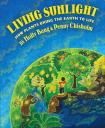Summary:
Living Sunlight How Plants Bring The Earth To Life, a book written by Holly Bang and Penny Chisholm. This book introduces kids to photosynthesis in a simplestic way. In the book it discusses how plants and animals take in the sunlight to grow and make food for the child who then eats the plants and drinks the sunlight and grows. Throughout the book the pulse of the child is seen as the pulse of the world and the warmth of the child is seen as the warmth of the sun. The colorful illustrations in the book are great for first and second graders. In conlusion this book can be used to teach students about the science cirrculum.
Curriculum Connection:
1.4(a) plants need air, water, light and a place to grow. The book describes how the sunlight melts glaciers, warms the land and create your winds . (c) The book then goes on to describe that the secret starts in green plants because they suck up H2o from the earth plants and can be classified on a variety of characteristics. (2.5a) With adquete food, shelter, space or cover the plants trap the energy as little packets.
Additional Resources:
Water experiments: Surface tension is one of water’s most important properties. It is the reason that water collects in drops, but it is also why water can travel up a plant stem, or get to your cells through the smallest blood vessels. Water experimetns allows you to experiment with surface tension using just a few household items.
People and Space: Students will understand preservation of food and space-saving storage, also what dehydration means and how dehydrated foods can be consumed by mixing the food with saliva from the eater's mouth or by adding water
The Living Earth: Discuss glaciers, how they change the land and how the planets structure changes
General Information:
Book: Living Sunlight
Author: Holly Bang & Penny Chisholm
Publication Date: 2006
Pages: 1-30
Grade Range: 1-3
ISBN: 3 3082 01074 2996

